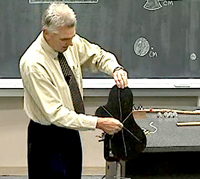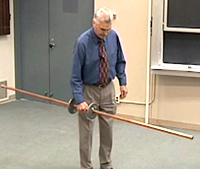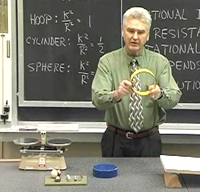
Torque, Center of Mass, and Rotational Inertia
Torque and Equilibrium
A torque is applied to various objects.

Click the image to watch the video
- Large clamp, wooden block with bolt attached, wrench
- Magnetically attached fulcrum, balance bar, weights
- Long T-shaped steel rod, weights
The concept of torque is explained and demonstrated using various examples.
Center of Mass and Equilibrium
Objects of various sizes and shapes are tested for their location of center of mass and equilibrium condition.

Click the image to watch the video
- Large clamp, wooden block, irregularly shaped but uniform wooden object, plumb line
- Magnetically attached fulcrum, balance bar, weights
- Leaning tower
- Plastic bird
- Bottle and wooden board
- Meter stick and hammer
- Two balls on either end of a rope
Various aspects of the concept of center of mass are discussed and demonstrated. The position of the center of mass as related to equilibrium is demonstrated by balancing several objects.
Rotational Inertia: Weights
Rotational inertia is demonstrated using a barbell with weights at various distances from the center.

Click the image to watch the video
- Long Rod
- Movable weights
Two movable weights are attached to a long rod and rotated by hand to demonstrate the concept of rotational inertia.
Rotational Inertia: Hoop and Disk
A hoop and a disk and various solid cylinders and spheres are rolled down an inclined plane.

Click the image to watch the video
- Inclined plane board
- Disk and hoop of equal mass and radius
- Solid cylinders of various masses and radii
- Solid spheres of various masses and radii
- Balance scale
A solid cylinder (disk) and a hollow cylinder (hoop) with equal masses and equal radii are simultaneously allowed to start from rest and roll a common distance down an inclined plane of fixed angle. The times to reach the bottom are compared. Also, in different demonstrations, times are compared for (1) solid cylinders of different masses and radii, (2) solid spheres of different masses and radii, and independently, (3) a solid sphere and a solid cylinder.